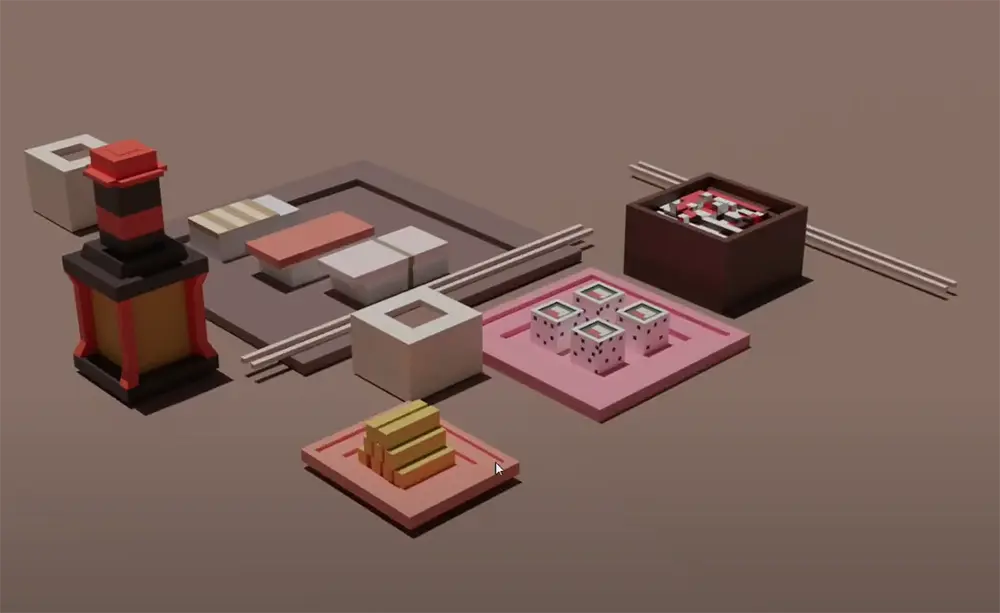A Culinary 3D Adventure: My Journey in Blender Low Poly Food Modeling
Project Overview: Crafting a 3D Culinary Masterpiece
In October 2020, I embarked on a creative journey that combined my love for food and 3D modeling using Blender 2.9. The goal was to create a low poly food scene that would showcase my skills in 3D modeling, texturing, and rendering. This project involved modeling various food items like sushi, rice balls, soup, chopsticks, chips, and a pepper holder. Each element was crafted with care to capture the essence of the dish while maintaining the simplicity of low poly design.
Background: Inspiration and Motivation
As an entrepreneur with a strong foundation in Graphic Designing, Video Editing/Animation, WordPress Development, and Social Media Management, I wanted to explore a different medium—3D art. Food, with its vibrant colors and intricate details, served as the perfect subject for this project. My aim was to create a visually appealing scene that could be used in games, animations, or as part of a digital portfolio.
Objectives: Enhancing Skills and Building Portfolio
The primary objectives of this project were to:
- Enhance my 3D modeling skills: Focus on mastering low poly techniques.
- Create a portfolio-worthy piece: Showcase my abilities in a new and exciting medium.
- Expand my marketable skills: Apply these new skills to fields like game development and digital content creation.
Strategy and Execution: The Process Unveiled
Concept Development
Before diving into Blender, I spent time researching and sketching out the different food items. I wanted to ensure that each element was recognizable and stayed true to the low poly style.
Modeling in Blender 2.9
Using Blender 2.9, I began by modeling the base shapes for each food item. The challenge was to capture the essence of each dish with as few polygons as possible—a hallmark of low poly design. For example:
- Sushi: Created using basic geometric shapes, with attention to the colors and layers.
- Rice Balls: Modeled with smooth, rounded edges to resemble their real-world counterparts.
- Soup and Chopsticks: Added details like floating ingredients and the delicate positioning of the chopsticks.
- Chips and Pepper Holder: Focused on creating crisp edges and texture.
Texturing and Lighting
Texturing played a crucial role in bringing these models to life. I used simple, flat colors to maintain the low poly aesthetic. Lighting was carefully adjusted to highlight the textures and shapes, giving the scene a warm and inviting feel.
Rendering the Final Scene
The final render was a culmination of all the hard work, showcasing the food items in a cohesive and visually pleasing composition. The simplicity of the design, combined with the vibrant colors, made the scene stand out.
Results: Bringing Food to Life in Low Poly
The project was a success, achieving all the goals set out in the beginning. The final renders were well-received, both by peers and professionals in the industry. The simplicity and charm of the low poly style resonated with viewers, making it a valuable addition to my portfolio.
Visual Showcase
Each food item was meticulously crafted, from the sushi’s colorful layers to the pepper holder’s simple elegance. The final render demonstrated a keen eye for detail and a deep understanding of low poly design principles.
Achievements and Learnings
This project honed my skills in:
- 3D modeling: Mastery of low poly techniques.
- Texturing: Effective use of flat colors to create depth.
- Lighting and Rendering: Achieving a balanced and appealing final image.
Marketable Skills and Expertise: Mastering 3D Art
This project not only enhanced my 3D modeling skills but also expanded my expertise in areas that are highly marketable in today’s digital landscape.
Relevant Skills
- 3D Modeling: Proficiency in creating low poly models using Blender 2.9.
- Texturing and Lighting: Expertise in applying textures and lighting to create a visually appealing final product.
- Cross-Disciplinary Expertise: Leveraged my background in Graphic Design and Video Editing to enhance the visual quality of the models.
Cross-Disciplinary Applications
These skills are highly relevant across various fields, including:
- Web Development: Enhancing visual elements on websites.
- WordPress Development: Creating custom 3D assets for websites.
- Social Media Management: Crafting unique and engaging visual content.
Testimonials: What Others Are Saying
The feedback from this project was overwhelmingly positive. Here are a few testimonials:
- “Hamid’s work on the low poly food scene was nothing short of impressive. The attention to detail and the clean, simple design make it a standout piece.” — Osman I., 3D Artist
- “The final render was not only visually stunning but also a testament to Hamid’s growing expertise in 3D modeling. This project truly showcases his versatility.” — Noah K, Graphic Designer
Certifications: Validating My Expertise
To further solidify my expertise, I have obtained several certifications relevant to this project:
- The Blender 2.8 Encyclopedia: Understanding the core principles of 3D modeling and animation.
- YouTube: Specialized training in low poly modeling techniques.
Contact Me: Let’s Create Together
If you’re looking for someone with a versatile skill set in 3D modeling, Web Development, or Social Media Management, I’d love to collaborate.
- Email: mr@hamidnuh.com
- LinkedIn: linkedin.com/in/hamidnuh
